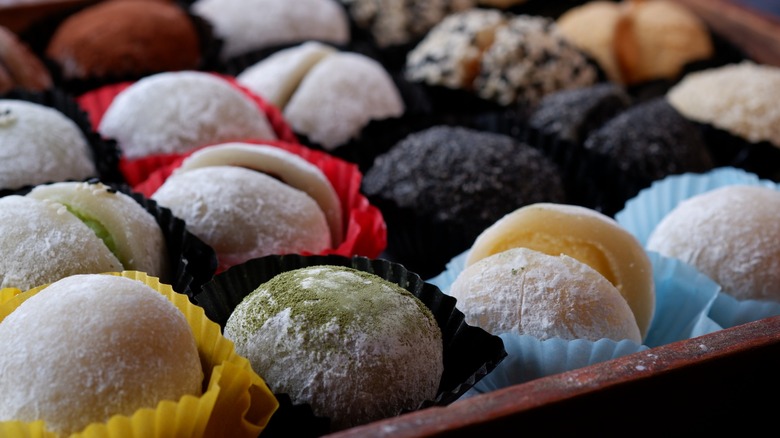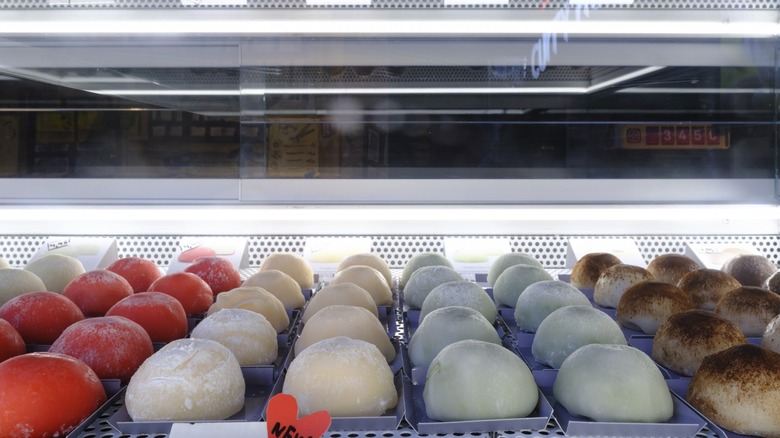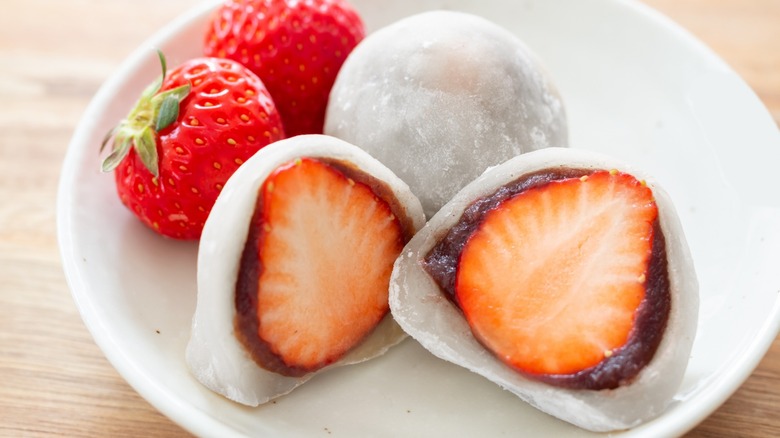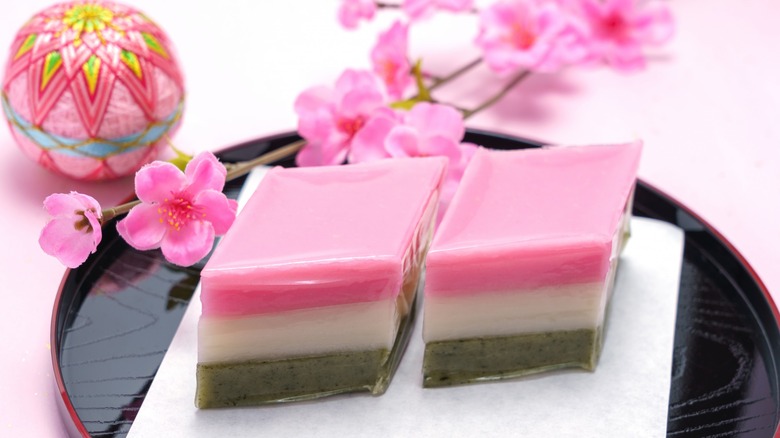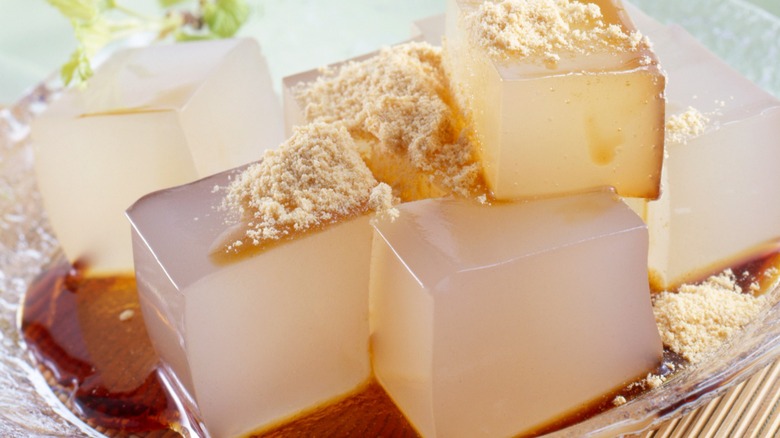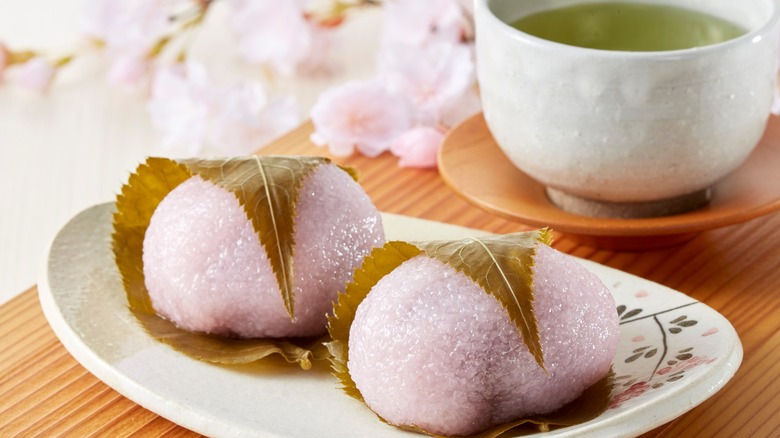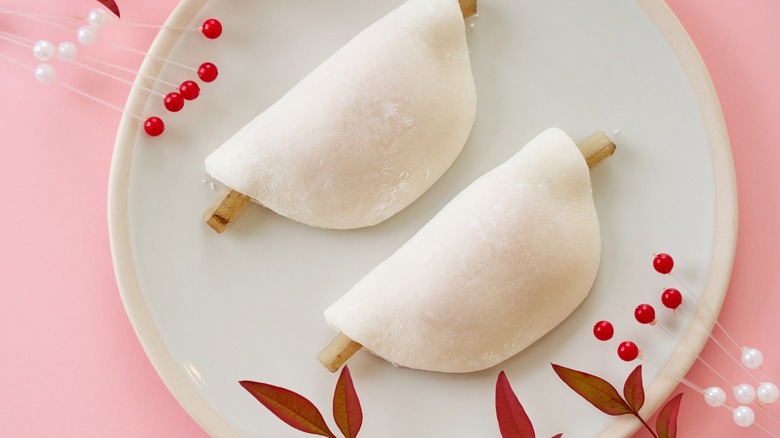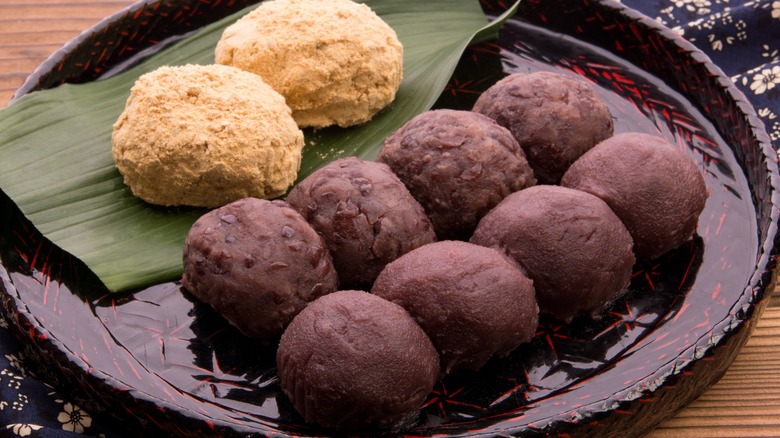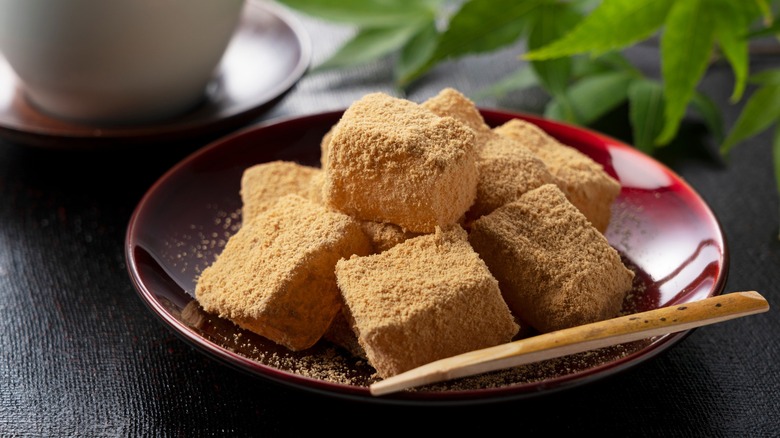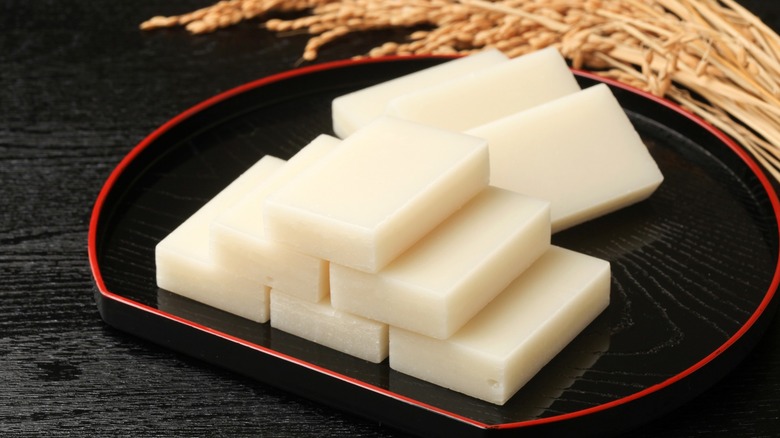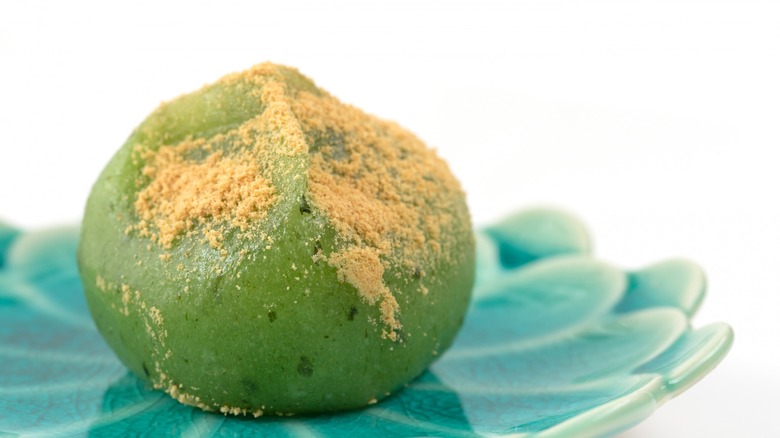How To Properly Store Every Type Of Mochi
Mochi is a type of rice cake popular in Japan that has a rich history dating back centuries. It comes in a variety of different shapes and can be made in many different ways, depending on its region of origin. Mochi is typically made by steaming mochigome (glutinous rice) and then pounding it with a pestle and mortar.
The chewy texture of mochi made it popular as far back as the Nara Period (710-794) when aristocrats enjoyed it. Later, during the Heian Period (794-1185), it became popular seasonally when it was eaten to celebrate special occasions. Today, mochi still plays a huge part in Japan's seasonal festivals and celebrations, such as Girl's Day and New Year's.
It's estimated that one Japanese household — of two or more people — consumes an average of 43 pieces of mochi per year. That's a lot of mochi!
Because of its bouncy, chewy texture, mochi is quite delicate to store. Careful attention needs to be paid to storage techniques to ensure that mochi remains fresh and delicious. We'll look at various different types of mochi and the optimal way to store each type, so you can always enjoy your mochi at its best.
1. What types of mochi exist?
There are many different types of mochi out there, depending on which region of Japan you're visiting. However, the nine most popular types of mochi are sakura mochi, daifuku mochi, ohagi/botamochi, kuzumochi, hishi mochi, warabi mochi, kusamochi, hanabiramochi, and marumochi/kirimochi.
Many mochi are commonly consumed during the spring months, such as sakura mochi, made with steamed glutinous rice and eaten during cherry blossom viewing time in Japan. Ohagi or botamochi are also often eaten during the spring and autumn equinoxes. Another popular spring mochi is the diamond-shaped hishi mochi, which is usually red or pink, white, and green.
Bright green kusamochi is also popular in the spring, while daifuku mochi is a sweet mochi that's generally filled with ice cream or red bean paste, making it popular in the summer.
When the weather heats up, warabi mochi, a refreshing mochi made with bracken starch, is another popular choice. Then there are the mochi typically consumed during New Year's in Japan, like hanabiramochi and marumochi, also known as kirimochi, which is bought pre-wrapped in blocks from Japanese stores. Finally, there's the less common kuzumochi, made with steamed and fermented starch from gluten found in wheat flour.
2. Daifuku mochi
Daifuku Mochi is heavier and sweeter than regular mochi. Yes, it has the same delicious chewy texture but it's much smoother and creamier. It's the filling in daifuku that makes it a heavier treat than most other mochi. Generally, daifuku is filled with sweet red bean paste or ice cream.
If your daifuku contains ice cream, it will need to be stored in the freezer. But, daifuku has a bit of a longer shelf life than plain mochi. You can store the fresh stuff in your refrigerator for one to two days. However, note that you should never refrigerate daifuku for longer than seven days. Not only will the mochi be past its best by this point, but it will also likely be hard and unpleasant to eat.
Of course, as with most other mochi, you should consume daifuku mochi the same day you purchase it to enjoy it at its best. If you've whipped it up yourself at home, it's also a good idea to enjoy it the same day you make it so that it's fresh and delicious.
3. Hishi mochi
There's no denying that hishi mochi is one of the prettiest types of mochi out there. This diamond-shaped mochi has three different layers colored pink (or red), white, and green.
You can make your own hishi mochi, but, like most other fresh mochi, it only keeps for around one day in the fridge. Store-bought hishi mochi can last up to a week in the refrigerator, stored in an air-tight container. In the freezer, it can last longer. However, we'd always recommend consuming this type of mochi as soon as possible, to ensure you're enjoying it at its best.
Hishi mochi has existed in its present form since the Edo Period. In some regions, two, five, or seven colors are used for this rhombus-shaped rice cake, but it's generally made up of three colors.
This type of mochi is linked to the Hinamatsuri festival or Girls' Day, celebrated in Japan on March 3. It's said to have the power to banish evil and is eaten by older people to promote the prosperity and well-being of young girls.
4. Kuzumochi
You can buy traditional kuzumochi from vendors around the Kawasaki Daishi Temple in Tokyo. Kuzumochi has no additives, so it has a much shorter shelf life than other types of mochi. It will keep for up to three days in a covered container in the fridge.
Kuzumochi has an interesting — and accidental — history. The story goes that when Mr. Kyubei found his barrel of wheat flour had been damaged by the rain and separated, he binned the gluten and used the converted starch to create a sweet similar in texture to mochi. This sweet was gifted to the head priest at Tokyo's Kawasaki Daishi Temple. The priest named the sweet "kuzumochi," with "zu" meaning "long life."
The fermented starch from wheat flour gluten is rinsed to remove any sourness, before being steamed to create kuzumochi. This type of mochi has a jelly or blancmange-like texture and a very subtle, barely detectable flavor.
Kuzuomochi normally comes topped with aromatic, nutty kinako (roasted soybean powder). You'll usually also find it is drizzled with kuromitsu, a type of Japanese syrup similar to molasses.
5. Sakura mochi
Sakura mochi are amongst the prettiest mochi around, with their delicate pink color. Traditionally, they're made with sticky glutinous rice, filled with red bean paste, and wrapped in a pickled cherry blossom leaf.
Sakura mochi are best consumed immediately and served at room temperature so that the rice maintains its sticky quality. If stored, the rice may take on an unpleasant texture and become hard. But, if you need to store these mochi, you can wrap them tightly in cling wrap and keep them in an airtight container in your fridge for up to three days.
These wagashi (Japanese sweets) were said to have originated in Tokyo in 1717, but over time two different styles of sakura mochi emerged. In Eastern Japan, Kanto-style sakura mochi are made, using a sweet glutinous rice flour known as shiratamako. Kansai-style sakura mochi comes from Western Japan, made with domyojiko, dried glutinous rice that's broken into small bits.
No matter which style of sakura mochi you eat, they're usually consumed during Hinamatsui, or Girls' Day, on March 3. They're also more generally eaten during cherry blossom season in the spring in Japan.
6. Hanabiramochi
Hanabiramochi is one of the types of mochi most commonly eaten at the New Year in Japan — usually during Hatsugama, the year's first tea ceremony. It's also served on Koshogatsu (little new year) on January 15 and throughout the seven days following New Year's, known as Matsunochi in Japan.
As with other varieties of mochi, Hanabiramochi is best consumed fresh to ensure the rice cake keeps its moist, chewy texture that makes mochi so delicious. If you absolutely must store it, wrap it tightly in plastic cling wrap and keep it in an airtight container in the fridge for up to three days.
Hanabiramochi literally means "flower petal mochi" due to its petal-like appearance. To make this type of mochi, a round rice cake is rolled thinly, then folded around a filling of red bean paste. The stalk sticking out the sides is gobo, or burdock root stalk.
A pink tinge from the red bean paste shows through the thin rice cake. While the pink hue of the mochi is representative of ume blossom, which itself symbolizes new beginnings, the burdock root symbolizes longevity.
7. Ohagi/botamochi
Botamochi, or ohagi, are small, sometimes round, sometimes cylinder-shaped sweet rice balls made with glutinous rice. They're coated in red bean paste for a deep color, and some varieties are stuffed with red bean paste and coated in ground, sweetened black sesame seeds.
Botamochi do have a much shorter shelf life than other mochi, though. Storing them in the fridge will make the rice hard, and the mochi will lose their chewy texture. Where possible, store them in a cool place in an airtight container, and consume them within 12 hours.
During a hot summer, you can store these mochi in an airtight container in the fridge, but cover the container with a thick towel to protect them. You can also freeze them for up to one month. Defrost them overnight in the refrigerator before using, and leave them to come to room temperature before eating, or heat them for a few seconds in the microwave.
These mochi are served during the Buddhist holiday Ohigan, which takes place during the spring and fall equinoxes. In spring, these mochi are known as botamochi, after the springtime flower, botan. In the fall, they're called ohagi, named after the fall flower, hagi.
8. Warabi mochi
Warabi mochi is a type of mochi that's not very well known outside of Japan. Its shelf life depends on its ingredients. If you're buying warabi mochi made with 100% warabi starch — or making your own — it won't keep longer than a day, so is best eaten immediately. Warabi mochi made using a mix of starches will usually last for a couple of days in an airtight container at room temperature.
This chilled mochi has a jelly-like texture that's chewy and dissolves quickly in your mouth. It usually comes topped with kinako (soybean flour) which adds a delightful nutty flavor to the mochi. Sometimes it's also drizzled with a sweet syrup known as kuromitsu.
Because it's served chilled, warabi mochi is most commonly served in the summer months as it's so refreshing. It's a great alternative to ice cream! To enjoy it at its best, refrigerate it for 20 to 30 minutes before eating.
9. Marumochi/kirimochi
Marumochi, more commonly known as kirimochi, means "cut mochi." Made with glutinous rice, it has no added sugar and comes in a hard, rectangle-shaped block wrapped in plastic. To soften this mochi, it needs to be cooked.
Kirimochi is shelf stable, so it will keep in your cupboard for a long time, usually up to several months. This makes it a good ingredient to have to hand if you're planning on making kagami mochi or yakimochi.
You'll find that kirimochi is an ingredient often used to make other types of mochi, such as yakimochi, a type of grilled mochi that's added to other recipes or enjoyed by itself. In the past, yakimochi was often eaten as an on-the-go snack or lunch by agricultural workers in Japan.
This type of mochi is generally available all year round, but it's most commonly eaten at New Year's. In Japan, Kirimochi is commonly used to make kagami mochi, a decoration that's placed in a home altar as an offering to the gods for New Year's. Once the New Year is over, the mochi is broken and eaten.
10. Kusamochi
If you're buying kusamochi at the store, it should keep for up to a week in an airtight container in the refrigerator. Making your own? Store it for one to two days in a container at room temperature. You can also freeze kusamochi for up to a month in an airtight container.
The vibrant green of kusamochi heralds the coming of spring, when this round or rhombus-shaped rice cake is generally enjoyed. "Kusa" means "herb" or "grass," referring not only to the bright green color of kusamochi but also to its main ingredient, yomogi, or Japanese mugwort leaves.
Made with glutinous rice flour, kusamochi has a delightfully chewy, light texture and a fresh, grassy aroma that's said to ward off evil spirits. Sometimes you'll find this type of mochi has a sweet bean paste center. The mugwort leaves also have some health benefits, as they're packed with vitamins B1, B2, C, and A, dietary fiber, and chlorophyll.
